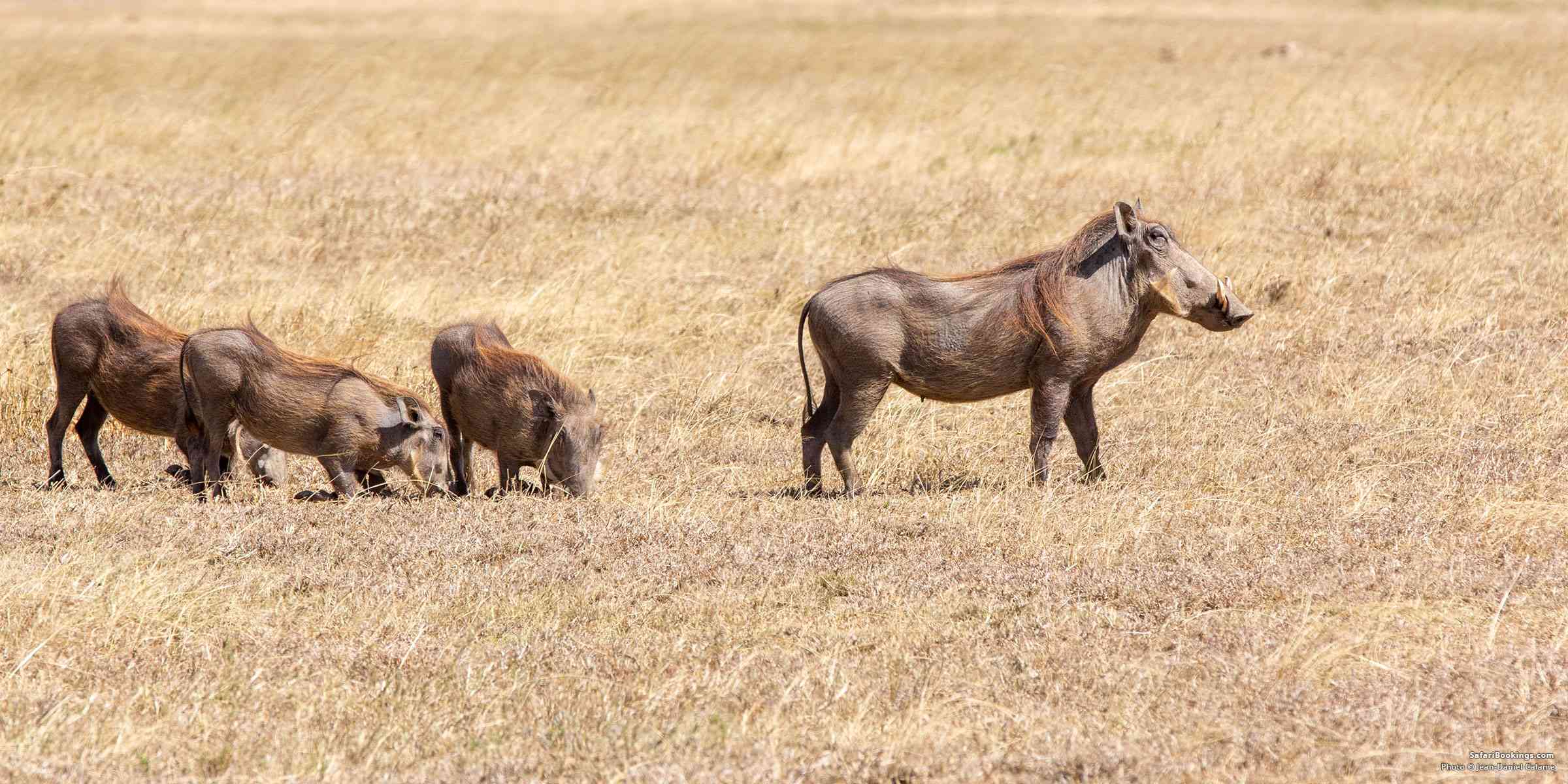
5 Fascinating Facts About the Incredible Warthog
 By Mike Unwin
By Mike Unwin
Mike is an award-winning wildlife writer, former editor of Travel Zambia magazine and author of the Bradt Guide to Southern African Wildlife.
The common Warthog is a popular porker! It was catapulted into celebrity by the unforgettable Pumba in Disney’s Lion King. It’s unmistakable, with its incongruous combination of delicate hindquarters and huge head. The latter adorned with bizarre warty protrusions, bushy whiskers and an impressive set of tusks (particularly in the male).
Its habits are equally odd: grazing on bended forelegs; entering its burrow backwards; trotting along with tail held erect, like a radio antenna. An omnivore, it uses its rubbery snout to grub up roots and tubers. It often wallows in mud to help regulate its temperature and rid parasites from its largely naked skin. The species familiar across sub-Saharan Africa is the common warthog. A separate species, the desert warthog (Phacochoerus aethiopicus), occurs in northern Kenya and the Horn of Africa. Although they reproduce at a high rate, the populations seem to be in a general decline. Below are five fascinating facts about warthog.
- Their tusks are enlarged canine teeth that protrude upwards from its mouth. There are two pairs: the shorter, lower pair are worn to a razor-sharp edge by rubbing against the longer, upper pair whenever the mouth is opened and closed. The upper pair can grow to 25cm. Warthog use their tusks for digging, fighting with rivals and defending themselves against predators. They have long been used as an alternative to ivory in ornamental carving.
- Calloused pads on warthogs’ wrists help protect them while they graze on bended forelegs. These pads form quite early in the development of the foetus.
- A variety of predators target warthogs, including lions, leopards, cheetahs, hyenas, wild dogs and crocodiles. Even large eagles and Verreaux’s eagle owls may snatch a young piglet. But adults – especially females with piglets – will defend themselves vigorously and often turn the tables on the predator, sometimes causing serious injuries with their tusks.
- Warthogs have been observed allowing banded mongoose and vervet monkeys to groom them in order to remove ticks from their hairless hides.
- Warthog sows may foster nurse piglets if they lose their own litter. This behaviour is known as allosucking and is thought to be a sign of altruism, rather than mistaken identity or milk theft. It means that they are classed as ‘cooperative breeders’.
Want To Go on an African Safari?
Click on the button below to compare African safaris offered by top-rated tour operators.
 By Mike Unwin
By Mike Unwin
Mike is an award-winning wildlife writer, former editor of Travel Zambia magazine and author of the Bradt Guide to Southern African Wildlife.
More About This AuthorAfrican Safari Tours
-
![5-Day Safari Experience with Comfortable Accommodations]()
5-Day Safari Experience with Comfortable Accommodations
$1,430 pp (USD)
Tanzania: Shared tour (max 6 people per vehicle)
Mid-range Lodge & Tented CampYou Visit: Arusha (Start), Lake Manyara NP, Tarangire NP, Serengeti NP, Central Serengeti NP, Ngorongoro Crater, Arusha (End)

Mercy Africa Serengeti Adventures
4.9/5 – 15 Reviews
-
![7-Day Private Luxury Serengeti Wildebeest Migration Tour]()
7-Day Private Luxury Serengeti Wildebeest Migration Tour
$3,520 pp (USD)
Tanzania: Private tourLuxuryLodge & Tented Camp
You Visit: Arusha (Start), Tarangire NP, Central Serengeti NP, Northern Serengeti NP, Serengeti NP, Ngorongoro Crater, Kilimanjaro Airport (End)

Meru Slopes Tours & Safaris
5.0/5 – 464 Reviews
-
![7-Day Tanzania Group Safari Wilderness Escape]()
7-Day Tanzania Group Safari Wilderness Escape
$1,144 pp (USD)
Tanzania: Shared tour (max 6 people per vehicle)BudgetCamping & Lodge
You Visit: Arusha (Start), Tarangire NP, Serengeti NP, Ngorongoro Crater, Lake Manyara NP, Materuni Waterfalls (Highlight), Arusha (End)

GoldFinch Expeditions
5.0/5 – 13 Reviews



 Subscribe to our newsletter
Subscribe to our newsletter
 Follow us on Instagram
Follow us on Instagram



_1813_5e20b935b89f3.gif)

